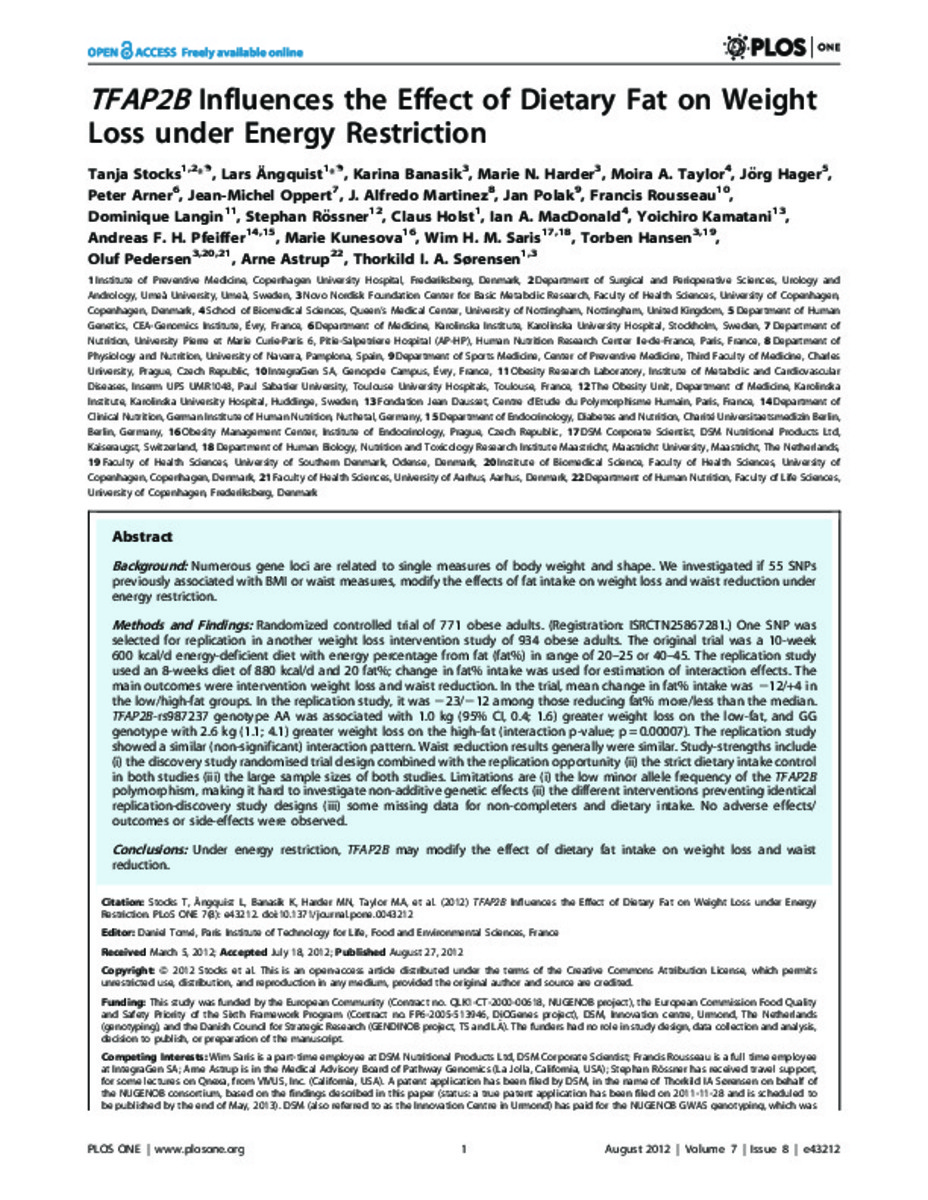Full metadata record
| DC Field | Value | Language |
|---|---|---|
| dc.creator | Stocks, T. (Tanja) | - |
| dc.creator | Ängquist, L. (Lars) | - |
| dc.creator | Banasik, K. (Karina) | - |
| dc.creator | Harder, M.N. (Marie N.) | - |
| dc.creator | Taylor, M. (Moira) | - |
| dc.creator | Hager, J. (Jörg) | - |
| dc.creator | Arner, P. (P.) | - |
| dc.creator | Oppert, J.M. (Jean M.) | - |
| dc.creator | Martinez, J.A. (José Alfredo) | - |
| dc.creator | Polak, J. (Jan) | - |
| dc.creator | Rousseau, F. (Francis) | - |
| dc.creator | Langin, D. (D.) | - |
| dc.creator | Rössner, S. (Stephan) | - |
| dc.creator | Holst, C. (C.) | - |
| dc.creator | MacDonald, I. (Ian) | - |
| dc.creator | Kamatani, Y. (Yoichiro) | - |
| dc.creator | Pfeiffer, A.F. (A.F.) | - |
| dc.creator | Kunesova, M. (Marie) | - |
| dc.creator | Saris, W.H.M. (Wim H. M.) | - |
| dc.creator | Hansen, T. (Torben) | - |
| dc.creator | Pedersen, O. (Oluf) | - |
| dc.creator | Astrup, A. (Arne) | - |
| dc.creator | Sørensen, T.I.A (Thorkild I. A.) | - |
| dc.date.accessioned | 2013-04-01T19:43:44Z | - |
| dc.date.available | 2013-04-01T19:43:44Z | - |
| dc.date.issued | 2012 | - |
| dc.identifier.citation | Stocks T, Angquist L, Banasik K, Harder MN, Taylor MA, Hager J, et al. TFAP2B influences the effect of dietary fat on weight loss under energy restriction. PLoS One 2012;7(8):e43212 | es_ES |
| dc.identifier.issn | 1932-6203 | - |
| dc.identifier.uri | https://hdl.handle.net/10171/28200 | - |
| dc.description.abstract | BACKGROUND: Numerous gene loci are related to single measures of body weight and shape. We investigated if 55 SNPs previously associated with BMI or waist measures, modify the effects of fat intake on weight loss and waist reduction under energy restriction. METHODS AND FINDINGS: Randomized controlled trial of 771 obese adults. (Registration: ISRCTN25867281.) One SNP was selected for replication in another weight loss intervention study of 934 obese adults. The original trial was a 10-week 600 kcal/d energy-deficient diet with energy percentage from fat (fat%) in range of 20-25 or 40-45. The replication study used an 8-weeks diet of 880 kcal/d and 20 fat%; change in fat% intake was used for estimation of interaction effects. The main outcomes were intervention weight loss and waist reduction. In the trial, mean change in fat% intake was -12/+4 in the low/high-fat groups. In the replication study, it was -23/-12 among those reducing fat% more/less than the median. TFAP2B-rs987237 genotype AA was associated with 1.0 kg (95% CI, 0.4; 1.6) greater weight loss on the low-fat, and GG genotype with 2.6 kg (1.1; 4.1) greater weight loss on the high-fat (interaction p-value; p = 0.00007). The replication study showed a similar (non-significant) interaction pattern. Waist reduction results generally were similar. Study-strengths include (i) the discovery study randomised trial design combined with the replication opportunity (ii) the strict dietary intake control in both studies (iii) the large sample sizes of both studies. Limitations are (i) the low minor allele frequency of the TFAP2B polymorphism, making it hard to investigate non-additive genetic effects (ii) the different interventions preventing identical replication-discovery study designs (iii) some missing data for non-completers and dietary intake. No adverse effects/outcomes or side-effects were observed. CONCLUSIONS: Under energy restriction, TFAP2B may modify the effect of dietary fat intake on weight loss and waist reduction. | es_ES |
| dc.language.iso | eng | es_ES |
| dc.publisher | Public Library of Science | es_ES |
| dc.rights | info:eu-repo/semantics/openAccess | es_ES |
| dc.subject | Obesity | es_ES |
| dc.subject | Weight loss | es_ES |
| dc.subject | Polymorphism, single nucleotide | es_ES |
| dc.subject | Transcription factor AP-2 | es_ES |
| dc.title | TFAP2B influences the effect of dietary fat on weight loss under energy restriction | es_ES |
| dc.type | info:eu-repo/semantics/article | es_ES |
| dc.type.driver | info:eu-repo/semantics/article | es_ES |
| dc.identifier.doi | http://dx.doi.org/10.1371/journal.pone.0043212 | es_ES |
Files in This Item:
Statistics and impact
Items in Dadun are protected by copyright, with all rights reserved, unless otherwise indicated.






